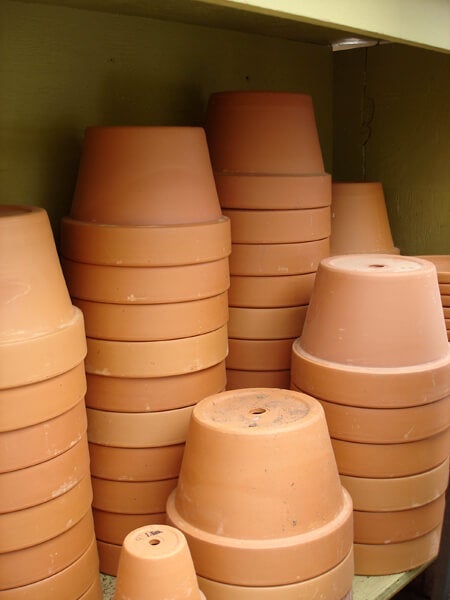When gardening in containers, you'll want to fill each pot with premium quality potting soil, such as Miracle-Gro® Potting Mix, to provide roots with the very best environment for growing. Look at the sizes of your containers to determine the size of the bag(s) you'll need to buy.For example, a 20-quart bag fills two 12-inch standard clay pots, or you can fill one 14-inch basket and still have enough to fill half of another 14-inch basket. To follow this example, find the pot sizes in the column on the left, and then follow the line to the right to the shaded boxes.
Size of Bag and Approximate Number of Pots It Fills
| Pot type & size | Approximate soil volume of pot*(dry quarts*) | 10-qt bag | 20-qt bag | 32-qt bag | 40-qt bag | 64-qt bag |
| STANDARD CLAY POTS | ||||||
| 8 ¼ inch | 3.6 | 3 | 5½ | 9 | 11 | 18 |
| 10 ¼ inch | 6.9 | 1½ | 3 | 4½ | 6 | 9 |
| 12 inch | 10.7 | 1 | 2 | 3 | 4 | 6 |
| 14 inch | 15.3 | ½ | 1¼ | 2 | 2½ | 4¼ |
| STRAWBERRY JAR | ||||||
| 5 gallon | 14 | ¾ | 1½ | 2¼ | 3 | 4½ |
| HANGING BASKETS | ||||||
| 10 inch | 5.5 | 2 | 3½ | 5¾ | 7 | 11½ |
| 12 inch | 7.9 | 1¼ | 2½ | 4 | 5 | 8 |
| 14 inch | 13.9 | ¾ | 1½ | 2¼ | 3 | 4½ |
| BOWLS | ||||||
| 8 inch | 1.9 | 5 | 10½ | 17 | 21 | 34 |
| 10 inch | 3.7 | 2½ | 5½ | 8½ | 11 | 17 |
| 12 inch | 5.5 | 1¾ | 3½ | 3½ | 7¼ | 11½ |
| 14 inch | 8.4 | 1¼ | 2½ | 3¾ | 4¾ | 7½ |
| 16 inch | 12.0 | ¾ | ¾ | 2½ | 3¼ | 5¼ |
| 18 inch | 18.8 | ½ | 1 | 1¾ | 2 | 3½ |
| 21 ¾ inch | 31.2 | ¼ | ½ | 1 | 1¼ | 2 |
| OVAL PLANTERS | ||||||
| 12 inch | 3.8 | 2½ | 5¼ | 8¼ | 10½ | 16¾ |
| 16 inch | 7.3 | 1½ | 2¾ | 4½ | 5½ | 8¾ |
| 20 inch | 9.4 | 1 | 2 | 3½ | 4¼ | 6¾ |
| SQUARE PLANTERS | ||||||
| 12 inch | 11.2 | 1 | ¾ | 2¾ | 3½ | 5½ |
| 15 inch | 23.0 | ½ | 1 | 1½ | 1¾ | 2¾ |
| WINDOW BOXES | ||||||
| 24 inch | 11.7 | 1 | 1½ | 2¾ | 3½ | 5½ |
| 30 inch | 15.6 | ½ | 1¼ | 2 | 2½ | 4 |
| 36 inch | 19.7 | ½ | 1 | 1½ | 2 | 3¼ |
This isn't perfect, but it beats a wild guess.
It's important to note that these figures are approximate. Here's why:
There are very few standards regarding container sizes and volumes. To make it even more confusing, containers that do list volume typically measure using liquid quarts. Of course, potting soil is not a liquid, so the bags contain dry quarts, each of which equals about 1 1/8 liquid quarts. Nor do these figures account for any packing down of the soil (the taller the container, the greater the compression). Compression can cause you to need 15% to 20% more soil. On the flip side, the soil that comes with your plants (around the roots) will add volume. In any case, it never hurts to have a little extra potting soil on hand.
It's a good idea to take notes about how much soil you use in your own pots, if you have containers that you use over and over again.
Store leftover soil in a dry place, perhaps in a clean plastic tub or garbage can, until the next time you need it.
Adapted from soil volume tables from Conrad Fafard, Inc., makers of commercial and home garden potting mixes.






 Herbs
Herbs
 Vegetables
Vegetables
 Fruit
Fruit
 Flowers
Flowers
 Succulents
Succulents


